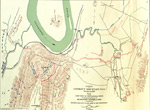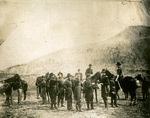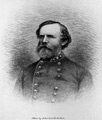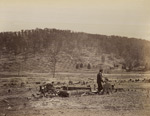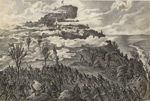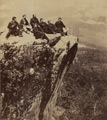Click Center Image for Full Size Picture
After being defeated at Chickamauga, Georgia, in September 1863, the Union retreated back to Chattanooga, Tennessee, a railroad town that each side wanted to hold. The Confederates held the high ground around it. The Union strengthened their numbers, and Major General Ulysses S. Grant planned an attack. On November 24, Union troops led by Major General Joseph Hooker took Lookout Mountain from Confederates under Major General Carter Stevenson. The next day was the battle for the neighboring Missionary Ridge. Union Major General William T. Sherman's initial attack was unsuccessful, but Major General George H. Thomas, who had stood firm while others fled at Chickamauga earning the nickname "Rock of Chickamauga," brought his soldiers who took the ridge.
In a letter home a few days after the battles, Cheney described for his wife "the awful grandeur of the scene" at Missionary Ridge, as well as some heroics he observed from his battery's position: "The color bearer nears the top. 'Will he live to plant that Flag on that Fort, or must he fall and another do it? it must, will be done' are our thoughts God grant he may. He leaps upon the parapet and the tattered and torn, but honored Flag waves in triumph over their fort."
Beyond the practical use of marking a unit's position on a battlefield, flags were symbols of a unit's pride in themselves and their country. As such they were never to touch the ground. Soldiers often stitched the names of battles on their unit flags, making the flag a history of a unit's actions. The stars on the American flag represented each state in the Union—during the Civil War it retained the thirty-nine stars as a symbol that the Union would be made whole again. Cheney wrote to his wife in July 27, 1863, that he felt the United States would "come out [of the war] without the loss of a single 'Star.'"
It was an honor for a soldier chosen to carry either the unit's flag or the American flag into battle, but dangerous. Enemy units would try to capture the flags or take down the bearers. Defense of their flags was a high priority, and fellow soldiers were quick to take up a flag if the color bearer fell. The act of planting the American flag on Missionary Ridge, former Confederate territory, symbolized reclaiming the land.
First Lieutenant/Adjutant Arthur MacArthur Jr., father of General Douglas MacArthur, was awarded a Medal of Honor years after the war for carrying and planting his regiment's flag atop Missionary Ridge.

